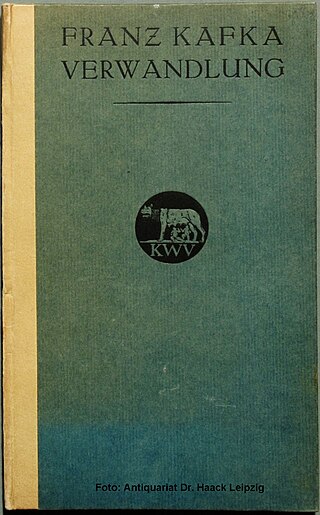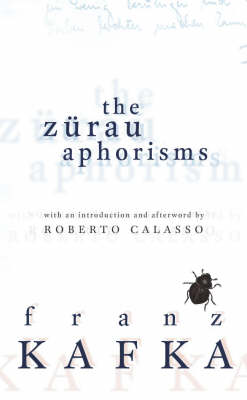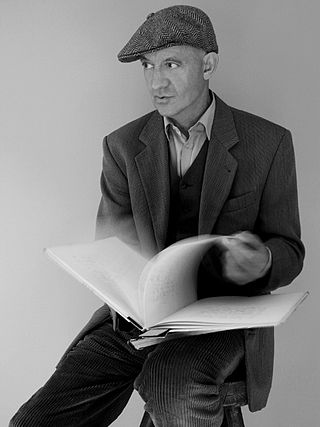
Franz Kafka was an Austrian-Czech novelist and writer from Prague. He is widely regarded as a major figure of 20th-century literature; he wrote in German. His work fuses elements of realism and the fantastic. It typically features isolated protagonists facing bizarre or surrealistic predicaments and incomprehensible socio-bureaucratic powers. It has been interpreted as exploring themes of alienation, existential anxiety, guilt, and absurdity. His best known works include the novella The Metamorphosis and the novels The Trial and The Castle. The term Kafkaesque has entered English to describe absurd situations like those depicted in his writing.

The Metamorphosis, also translated as The Transformation, is a novella by Franz Kafka published in 1915. One of Kafka's best-known works, The Metamorphosis tells the story of salesman Gregor Samsa, who wakes one morning to find himself inexplicably transformed into a huge insect and struggles to adjust to this condition. The novella has been widely discussed among literary critics, who have offered varied interpretations. In popular culture and adaptations of the novella, the insect is commonly depicted as a cockroach.

The Circus is a 1928 silent romantic comedy film written, produced, and directed by Charlie Chaplin. The film stars Chaplin, Al Ernest Garcia, Merna Kennedy, Harry Crocker, George Davis and Henry Bergman. The ringmaster of an impoverished circus hires Chaplin's Little Tramp as a clown, but discovers that he can only be funny unintentionally.

"A Hunger Artist" is a short story by Franz Kafka first published in Die neue Rundschau in 1922. The story was also included in the collection A Hunger Artist, the last book Kafka prepared for publication, which was printed by Verlag Die Schmiede shortly after his death. The protagonist, a hunger artist who experiences the decline in appreciation of his craft, is typically Kafkaesque: an individual marginalized and victimized by society at large. "A Hunger Artist" explores themes such as death, art, isolation, asceticism, spiritual poverty, futility, personal failure and the corruption of human relationships. The title of the story has also been translated as "A Fasting Artist" and "A Starvation Artist".

"In the Penal Colony" is a short story by Franz Kafka written in German in October 1914, revised in November 1918, and first published in October 1919. As in some of Kafka's other writings, the narrator in this story seems detached from, or perhaps numbed by, events that one would normally expect to be registered with horror. Internal clues and the setting on an island suggest Octave Mirbeau's The Torture Garden as an influence. The story is set in an unnamed penal colony and describes the last use of an elaborate torture and execution device that carves the commandment that the condemned prisoner has transgressed on his skin as he slowly dies over the course of twelve hours. As the plot unfolds, the reader learns more and more about the machine, including its origin and original justification.

Amerika, (German working title Der Verschollene, "The Missing") also known as Amerika (The Man Who Disappeared), Amerika: The Missing Person and Lost in America, is the incomplete first novel by author Franz Kafka (1883–1924), written between 1911 and 1914 and published posthumously in 1927. The novel originally began as a short story titled "The Stoker". The novel incorporates many details of the experiences of his relatives who had emigrated to the United States. The commonly used title Amerika is from the edition of the text put together by Kafka's close friend, Max Brod, after Kafka's death in 1924. It has been published in several English-language versions, including as Amerika, translated by Edwin and Willa Muir (1938); as Amerika (The Man Who Disappeared), translated by Michael Hofmann (1996); as Amerika: The Missing Person, translated by Mark Harman (2008), as Lost in America, translated by Anthony Northey (2010), and as The Man Who Disappeared (America), translated by Ritchie Robertson (2012).

The Hartford circus fire, which occurred on July 6, 1944, in Hartford, Connecticut, was one of the worst fire disasters in United States history. The fire occurred during an afternoon performance of the Ringling Bros. and Barnum & Bailey Circus that was attended by 6,000 to 8,000 people. The fire killed at least 167 people, and more than 700 were injured. It was the deadliest disaster ever recorded in Connecticut.

Michael Kohlhaas is a novella by the German author Heinrich von Kleist, based on a 16th-century story of Hans Kohlhase. Kleist published fragments of the work in volume 6 of his literary journal Phöbus in June 1808. The complete work was published in the first volume of Kleist's Erzählungen (novellas) in 1810.

Princess Python is a supervillain appearing in American comic books published by Marvel Comics.

"Before the Law" is a short story by Czech writer Franz Kafka. It was printed twice during Kafka's life, but is best known as an embedded narrative in the posthumously published novel The Trial. "Before the Law" is described as a deliberately obscure parable or allegory on legal bureaucracy and the seeking of justice, reflecting the absurdist views on the subject expressed by Kafka in The Trial.

Reading Like a Writer is a writing guide by American writer Francine Prose, published in 2006.

Betrachtung is a collection of eighteen short stories by Franz Kafka written between 1904 and 1912. It was Kafka's first published book, printed at the end of 1912 in the Rowohlt Verlag on an initiative by Kurt Wolff.

Franz Kafka, a German-language writer of novels and short stories who is regarded by critics as one of the most influential authors of the 20th century, was trained as a lawyer and later employed by an insurance company, writing only in his spare time.

Lola Montès is a 1955 historical romance film, and the last completed film of German-born director Max Ophüls. Based on the novel La vie extraordinaire de Lola Montès by Cécil Saint-Laurent, the film depicts the life of Irish dancer and courtesan Lola Montez (1821–1861), portrayed by Martine Carol, and tells the story of the most famous of her many notorious affairs, those with Franz Liszt and Ludwig I of Bavaria. A co-production between France and West Germany, the dialogue is mostly in French and German, with a few English-language sequences.
"Jackals and Arabs" is a short story by Franz Kafka, written and published in 1917. The story was first published by Martin Buber in the German monthly Der Jude. It appeared again in the collection Ein Landarzt in 1919.

The Zürau Aphorisms are 109 aphorisms of Franz Kafka, written from September 1917 to April 1918 and published by his friend Max Brod in 1931, after his death. They are selected from his writing in Zürau in West Bohemia where, suffering from tuberculosis, he stayed with his sister Ottla. His friend Max Brod titled the book "Betrachtungen über Sünde, Hoffnung, Leid und den wahren Weg".

A Country Doctor is a collection of short stories written mostly in 1917 by Franz Kafka, containing the story of the same name. Kurt Wolff published it in 1919 as the second collection of stories by Kafka, after Betrachtung.
Ilse Haider is an Austrian artist. She focuses on photography and her photographic works use three dimensional surfaces. She has received a number of awards for her work and her work has appeared in exhibitions throughout Europe and the United States.

Natias Neutert is a German artist, author, poet, orator, and translator who lives in Hamburg and Berlin.

Liddy Bacroff was a performer and sex worker of Weimar Republic era, persecuted and killed by the Nazi regime during World War II. Bacroff rejected her male gender role assigned at birth and self-identified as a "transvestite". Bacroff was imprisoned several times for "homosexual acts" under Paragraph 175 of the German Criminal Code and ultimately killed in the Mauthausen concentration camp.




















